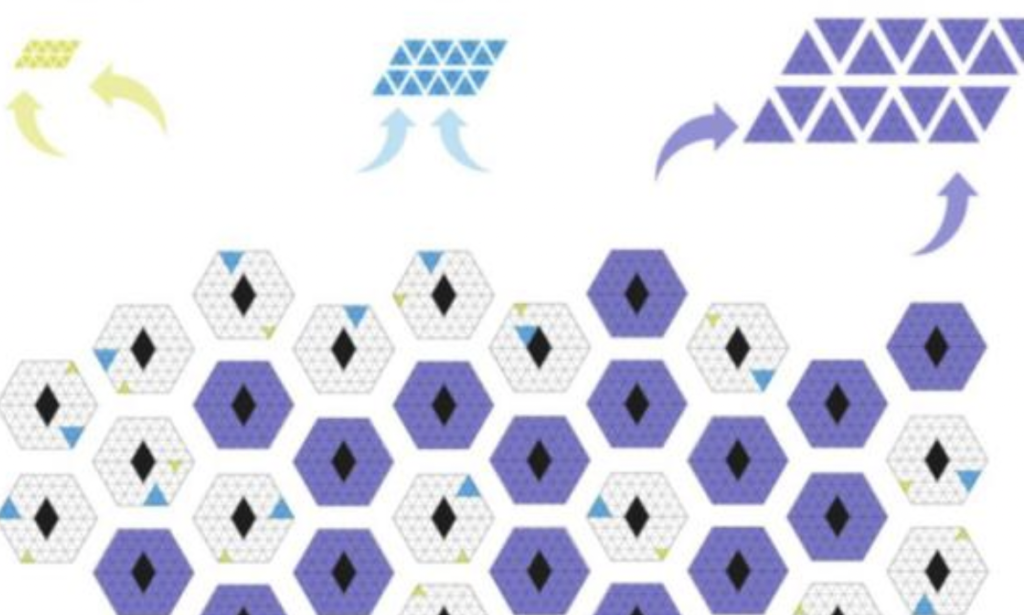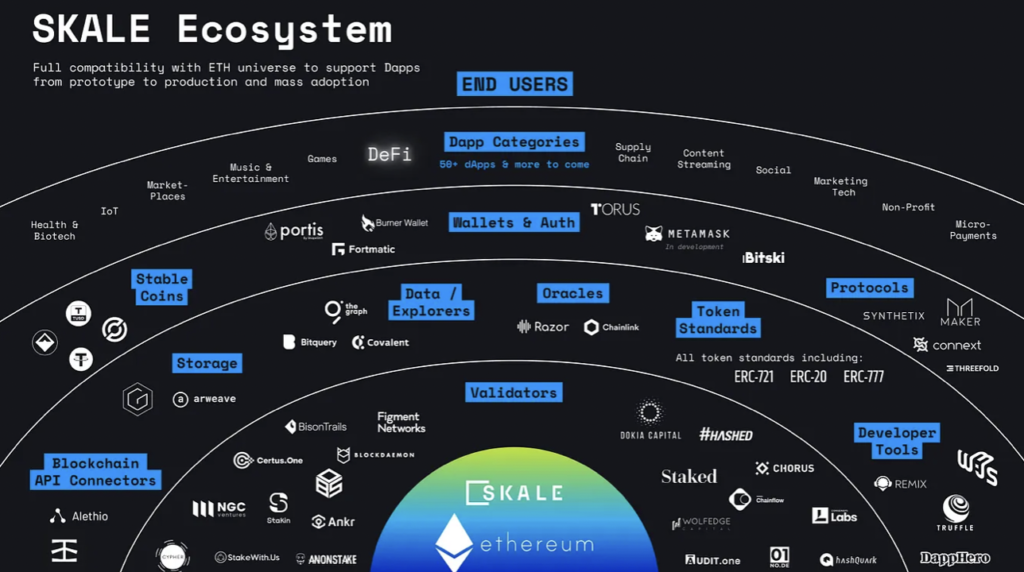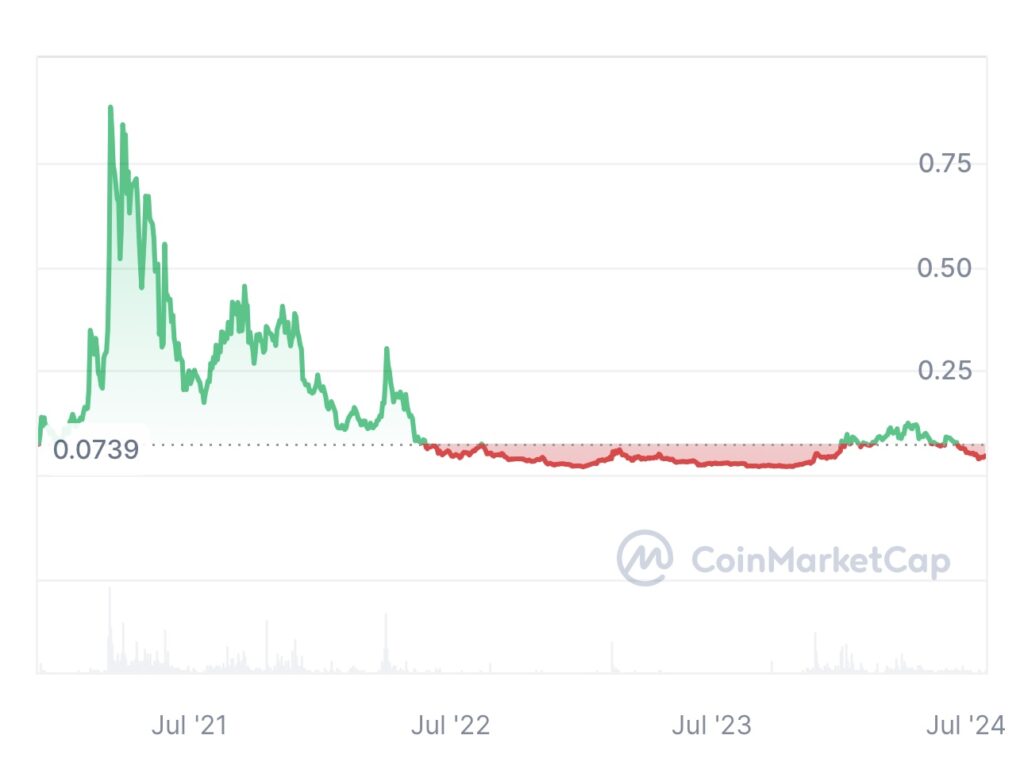SKALE Network: Market Analysis and Investment Insights
By Jenny Yao | Crescent City Capital Market Analyst Intern
Introduction
The SKALE Network positions itself as an “elastic sidechain network” for Ethereum, capable of supporting thousands of independent blockchains, sidechains, storage chains, and other types of subchains. These blockchains are connected to the Ethereum mainnet and are fully compatible with the Ethereum ecosystem. The sidechains within the SKALE Network are operated by a group of Virtualized Subnodes selected from the network’s pool of nodes. Each sidechain is highly configurable, allowing users to freely choose the specifications, consensus protocols, virtual machines, parent chains, and customized security measures for their sidechains. The SKALE Network uses Solidity as the programming language for smart contracts, and its operating model is fully compatible with the EVM. It supports mainstream Ethereum token standards and can be connected to the network via web3.js and web3.py. Additionally, tools like Truffle and Remix can be used, making it developer-friendly.

The structure of the SKALE Network
The SKALE Network consists of SKALE nodes and the SKALE Manager, the latter being a smart contract deployed on the Ethereum mainnet. The SKALE Manager contract acts as the “gateway,” handling tasks such as the creation and destruction of nodes, the creation and destruction of elastic sidechains, the rotation of virtual subnodes, and the distribution of SKALE rewards. Virtual subnodes, which are participants in the elastic sidechains, are responsible for executing SKALE consensus, running the SKALE EVM, and facilitating interchain communication.
1.)The creation and destruction of nodes
To transition a potential node into a SKALE Network node, the following steps are required:
- First, run the SKALE daemon, which will evaluate whether the potential node meets the network’s hardware requirements.
- If the evaluation is successful, the potential node can submit an application to the SKALE Manager to join the network. The application requires staking a network deposit and providing node metadata such as its IP address, port, and public key.
- Once the application is submitted, the potential node joins the system and becomes either a “full node” or a “light node” (the difference being that a full node provides all resources for a specific elastic sidechain, while a light node participates in multiple elastic sidechains).
After a node is created, the SKALE Network assigns it a group of peer nodes (currently 24). These peer nodes will periodically review the node’s downtime and latency to determine the rewards issued to the node for each network cycle.
2.)The creation and destruction of elastic sidechains
One of SKALE’s innovative features is its customizable “elastic sidechains,” which allow users to adjust their blockchain configurations based on specific needs. Users can choose node resources in fractions of 1/128 (small), 1/16 (medium), or 1/1 (large), select durations of 3, 6, or 12 months, and determine the network’s storage capacity, paying rent with SKALE tokens. The cost of resources is based on the chain’s specifications and lifecycle, dynamically adjusting based on network conditions. If the rent is exhausted or the sidechain is deleted, it will be destroyed. Users can also rotate virtual subnodes to ensure decentralization and prevent collusion. Overall, this model resembles renting cloud servers, where resources are chosen on demand and paid for accordingly, aligning with SKALE’s vision of providing decentralized “chain services.

How To Use Skale Work
SKALE Network is used by Dapp developers who often experience issues with Dapp functionalities, testing, creation, and transactions whenever the Ethereum network becomes congested. As Ethereum is yet to transition from the Proof of Work protocol to Proof of Stake which represents a more efficient protocol, SKALE relieves the problem of congestion by interconnecting with Ethereum through the use of Elastic Sidechains.
Developers can test Dapps without affecting the front-end on the mainnet and can easily switch to customizable sidechains with fast execution of transactions and functions for Dapp creation and testing when GAS prices skyrocket on Ethereum. The price of GAS on Ethereum can often make Dapp development too expensive, unsustainable and unprofitable, which is why SKALE makes a great alternative for Ethereum Dapp developers.
The SKL token is used for staking and for the reward system that incentivizes validator nodes, while SKL can also be traded in the market to generate profits.

Skale Ecosystem
SKALE launched the first phase of its mainnet in June 2020. In May 2021, after completing the Denali upgrade, SKALE announced the official launch of its upgraded mainnet. This network upgrade introduced multichain capabilities to Ethereum and implemented a modular architecture for the SKALE Network, allowing it to support native and third-party chain services, including file storage, interchain messaging, Oracles, and Rollups. It also introduced high-performance app-specific chains, meaning each dApp and protocol can run on its own EVM-compatible chain, isolated from other network traffic but inheriting the security of the Ethereum mainnet. In terms of funding, SKALE Labs announced in October 2019 that it had raised a total of $17.1 million, receiving support from over 40 angel investors and venture capital firms, including Arrington XRP Capital, Blockchange, ConsenSys Labs, Hashed, HashKey, and Multicoin Capital, among others.
Market Analysis

According to the latest report as of November 2023, SKALE is positioned at the forefront as the most active Web3 gaming chain. It boasts 230,000 daily active addresses, thanks to its zero Gas fee blockchain model which significantly reduces the barrier of entry for gamers. In 2022, SKALE announced a $100 million ecosystem incentive program aimed at fostering developer activities on its platform. This initiative is a collaborative effort involving multiple entities including NODE Anstalt, SKALE DAO, and other nonprofit organizations. The initial $5 million grant from SKALE is earmarked for projects in the Play-to-Earn (P2E) gaming and metaverse sectors. The momentum of SKALE’s ecosystem remains strong with a 130% increase in active users from October, surpassing 2.3 million in November, and facilitating over 30 million transactions. Notably, SKALE’s technical infrastructure is naturally suited for AI projects, coinciding with the current AI boom, which likely contributes to the recent rise in SKL asset prices. Presently, the thriving and dynamic SKALE ecosystem is asserting its pivotal role in Web3.
Summary
SKALE Network provides an effective way for Dapp developers to test, host, and create Dapps in a highly scalable environment where devs can adjust and customize sidechain specifications, making them elastic. Ethereum often experiences congestion problems, which is when the price of GAS can skyrocket, making Dapp development on Ethereum expensive and unsustainable.
SKALE Network solves this issue and assists Dapp developers in the creation, development, and testing of EVM-based decentralized applications while enabling fast transactions with lower fees.
SKALE Network price is subject to frequent changes due to the high volatility in the cryptocurrency market. SKALE can be affected by a great number of factors, which is why SKL price can change radically within a short timeframe. Overall, Skale is a good investment choice.
References
https://kriptomat.io/cryptocurrency-prices/skale-skl-price/what-is

